Haunting Last Photos Of The Romanovs
Animosity toward Russia's ruling class had already been building for centuries when the House of Romanov took power. But a series of violent suppressions and a mounting death toll during World War I ultimately led to the fall of the last empire in Russia, the final Tsar Nicholas II, and his family.
These haunting photos depict the lives of the Romanovs before their executions in 1918. The remains of the Romanov family members weren't discovered until nearly six decades after their brutal slaying. Take a look at the shocking discovery, as well as intimate final photos of the family.
A Family’s Last Days Together
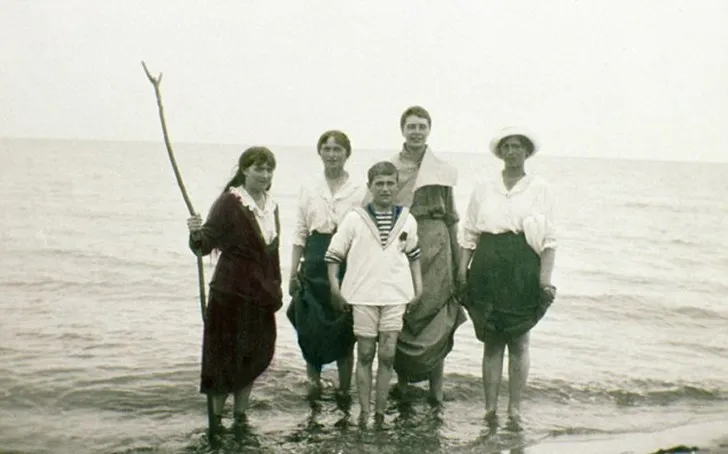
In this photo, the last tsar of Russia’s children pose for a photo while standing in shallow water during a day at the beach. This snapshot captures Maria, Alexi, & Anastasia, along with an unknown child. Alexi would have been about 13 years old when the picture was taken.
Prince Alexei, The Tsar’s Only Son

Unfortunately, Alexei was plagued with health problems during his brief life.
This photo, also part of the family’s personal collection, captures a very young Prince Alexei sitting at the table with his father, Tsar Nicholas II. This candid moment reveals none of the political turmoil that was brewing beneath the surface. Prince Alexei was the only male child of Tsar Nicholas II and his wife Tsarina Alexandra, who also had four daughters. As the heir apparent, Alexei was doted on by his parents and sisters, and was affectionately referred to as Alyosha. Alexei’s health was always a concern; he inherited hemophilia from his mother, which made trivial injuries like a bruise potentially life threatening.
A Royal Elephant
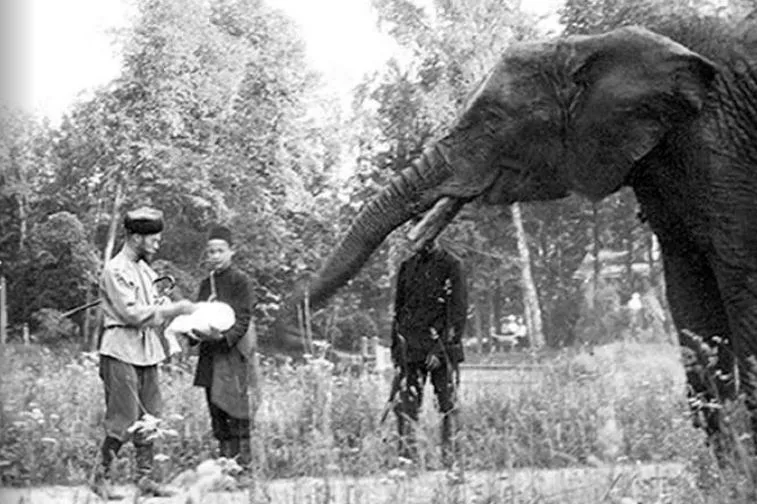
Sadly for them, the luxurious lifestyle the Romanov children were accustomed to would not last forever.
The above photograph was taken in 1914, and in Tsar Nicholas' journal, he wrote: "Took the elephant to our pond with Alexei today and had fun watching him bathe." The elephant was apparently at the zoo on the family’s royal estate; however, after the 1917 Russian revolution, the zoo was closed. It is unknown what exactly became of the elephant or the other animals for that matter. It is quite interesting to see the juxtaposition of such a happy photograph of a family that was able to have their own personal zoo with the fate that awaited them.
Military Service And Involvement

As we'll read, the entire royal family helped service members in times of need.
The above photo shows Tsar Nicholas II visiting a regiment of Kuban Cossacks in Russia along with his children during World War 1. The Tsar's older daughters and wife helped nurse wounded soldiers as volunteers with the Red Cross during the war, though Anastasia was too young to help, so she played games of checkers and billiards with soldiers to lift their spirits instead. During the war, Nicholas II took command of the army on the front lines. The war also provided an opportunity for his wife, Alexandra, to influence him toward an authoritarian government approach. Her German origin injured the Romanovs' reputation during this time.
A Favorite Daughter

Tatiana was not just favored and beautiful, she was also civic-minded.
This photograph from the Beinecke Library’s collection shows Empress Alexandra walking with her second daughter, Grand Duchess Tatiana Nikolaevna. During her lifetime, Tatiana was the best known of the Romanov family’s daughters. She was said to be the daughter who most favored her mother, Alexandra, and was often said to be her mother’s favorite daughter. Tatiana became a skilled Red Cross nurse when the war broke out, along with Alexandra and her sister, Olga. They cared for wounded soldiers in a private hospital on the Tsarskeo Selo grounds before the Romanov family was arrested during the Russian Revolution of 1917.
The Romanov Daughters
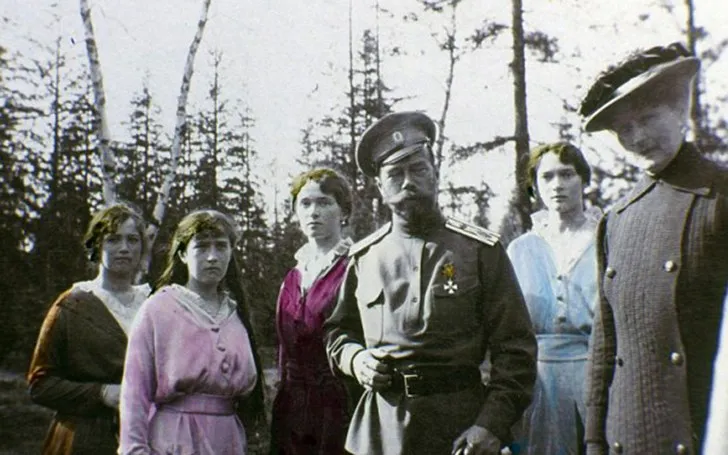
As we’ll learn, the four girls split into pairs according to age.
In the photograph from the Beinecke Library’s collection of recovered Romanov family albums, Tsar Nicholas II is pictured with his daughters, Maria, Anastasia, Olga, and Tatiana. All four daughters were born before the heir apparent, Alexei. Olga was closest to Tatiana. They were known as “The Big Pair." They were always seen together. Maria and her younger sister Anastasia were known as “The Little Pair.” Like Olga and Tatiana, they shared a room and dressed alike. The four girls were raised as simply as possible, sleeping on hard cots when they weren’t ill, and taking cold baths in the morning.
The Daughters, Growing Up

The daughters were not just beautiful, but talented as well.
Olga, Tatiana, Maria, and Anastasia, are pictured in this formal portrait taken in 1916, just two years before their execution. With pearls on their necks, they pose in evening gowns in one of the salons, which is decorated with French furniture. Behind them is an organ with sheet music, which all of Tsar Nicholas II’s daughters learned how to play. Tatiana was the best player of the four girls. The relaxed portrait shows no sign of the tragedy that would soon befall the Romanov girls. In just a year, they would be placed under house arrest and confined to their quarters.
Life Before The Revolution

There was even romance that bloomed as a result of helping with the war.
The eldest Romanov daughters prominently worked as nurses throughout World War I. Valentina Chebotareva was a nurse that worked alongside Olga and the two became very close. According to Valentina, Olga met the love of her life while caring for a wounded soldier named Dmitri Chakh-Bagov. The two loved each other so much, that he even offered to kill Rasputin, who many believed had a negative influence on the family. The daughters took their duties seriously and were very dismayed when they weren't able to continue after their imprisonment in the time leading up to their eventual execution.
War Took Its Toll

Olga even resorted to some serious "medication" to help ease the stress.
The increasing death rate among her citizens caused a lot of stress on Olga. She acted out her stress with bouts of rage, even at one point breaking a window. Instead of remaining with medical units to nurse wounded and dying soldiers, Olga was ultimately relocated to an office position to ease her nerves. She was reported to have been given arsenic injections to treat depression and anxiety, as medical professionals at the time did not think that arsenic was poisonous. Also adding to Olga's stress was her awareness of the country's politics and how her family was perceived by the public.
The Beginning Of The End
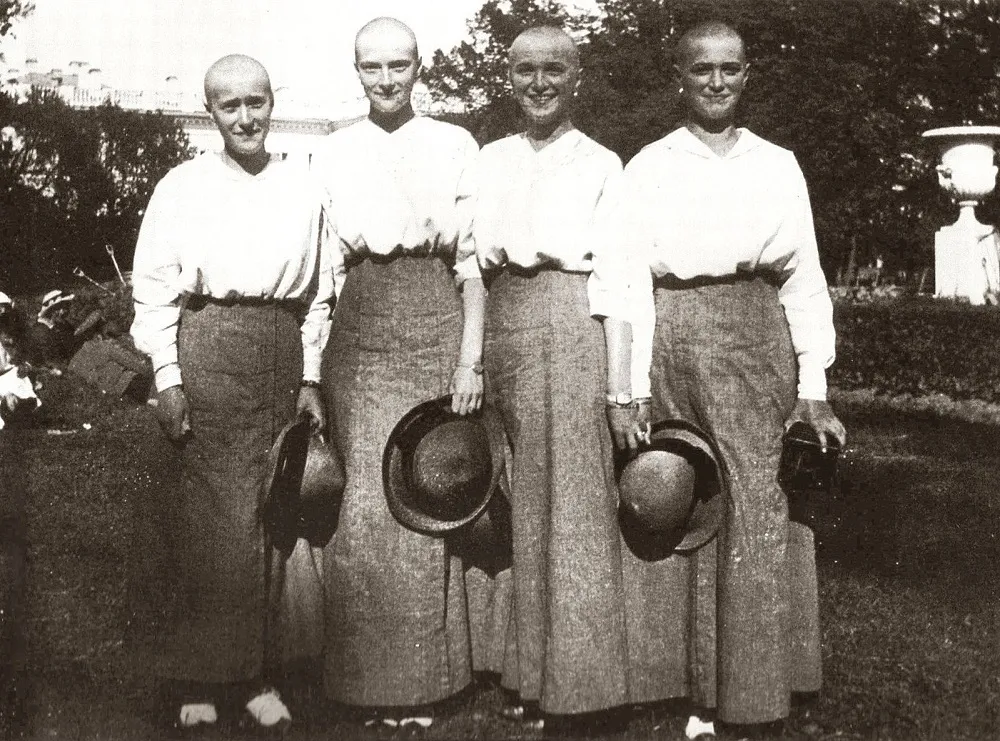
Although they appear to be coping well in the above photo, captivity was rough on the family.
The Romanov daughters are pictured here looking very different from the formal piano portrait they took together just a year earlier. The grand duchesses shaved their heads in the spring of 1917 after a bout with measles. Captivity certainly took its toll on the Romanovs. Grand Duchess Tatiana was reportedly most upset that she couldn’t continue her work tending to wounded soldiers as she had as a World War I Red Cross nurse. She wrote to fellow nurse Velentina Chebotarev in April 1917, “It is strange to sit in the morning at home, to be in good health and not go to change the bandages!”
The Children Playing at Wolfsgarten

The children had no idea that they only had a few years left to live.
When thinking about the gruesome end that befell the Romanov children, it’s strange to look at earlier photographs of them playing. Grand Duchess Maria, Tsarevich Alexei, Georg Donatus, the Hereditary Grand Duke of Hesse, and Grand Duchess Anastasia are pictured here playing with a toy car at Schloss Wolfsgarten, a royal hunting lodge. The photograph was taken in the Autumn of 1910, when Anastasia was just nine years old, Alexei was six years old, and Tatiana was thirteen years old. Tatiana was the only one of the Romanov children pictured above who would live to see the first year of her twenties. Her older sister Olga had a slightly longer life, as she was executed at age twenty-two.
Banished From Their Own Home

The imperial family was separated during their banishment, but would be executed together.
After initially being sent to their family home is Tsarskoe Selo, the family was finally relocated to Siberia. Tsar Nicholas, Tsarina Alexandra, and their daughter Maria were first sent to Yekaterinburg, leaving the rest of the family behind because Alexei could not be moved due to his hemophilia. After he was better and confined to a wheelchair, the entire family eventually was back together again at Tobolsk. Other distant members of the family were sent to Crimea instead of Siberia. Those who reached Crimea survived the revolution and were not killed. The same can't be said for the main members of the Romanov family.
In Captivity at Tobolsk
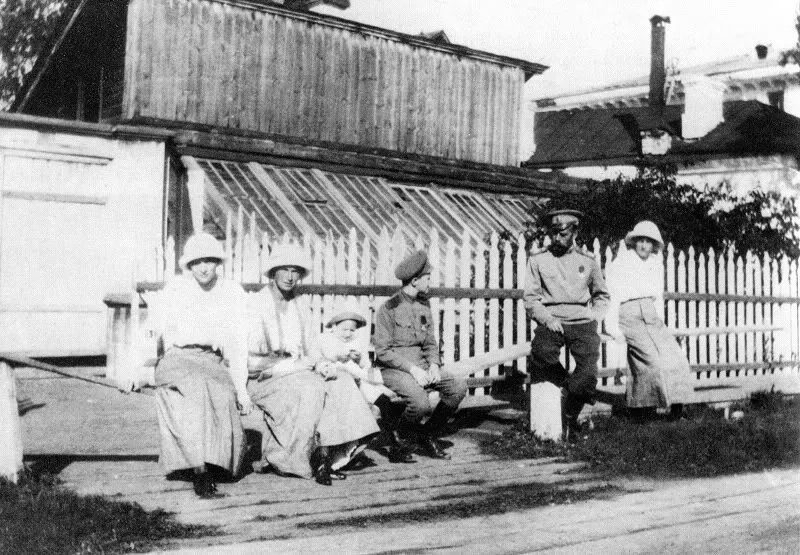
Although the Romanovs were relatively comfortable staying in the mansion, things were about to get worse for them.
The photograph above offers a glimpse into the Romanov’s captivity at Tobolsk. The former Tsar, Nicholas II, sits with Tatiana, Olga, a little boy of a servant, Alexei, and Anastasia on a fence in front of a greenhouse. In August of 1917, the Romanovs were sent to Tobolsk by Alexander Kerensky’s provisional government, supposedly to protect them from the revolution. They lived in the former governor’s mansion in relative comfort until October 1917 when the Bolsheviks came to power. Then, the conditions of their imprisonment became stricter. The photograph above was taken in September 1917, just a month before life would become even more difficult for the Romanovs.
The Last Photograph of Empress Alexandra
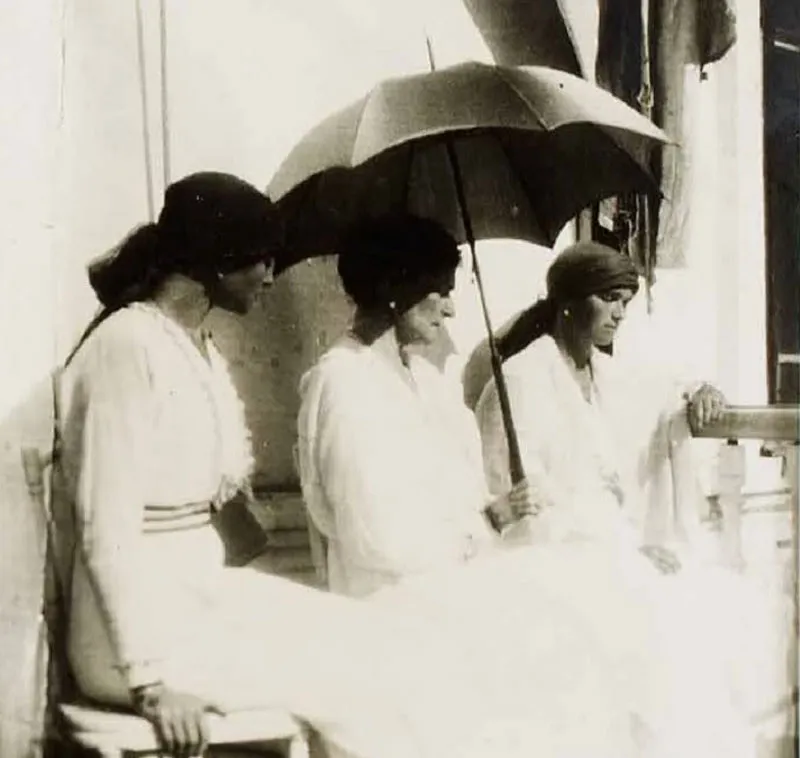
Just months later, everyone in this photo would be dead.
The photograph above is believed the be the last photograph ever taken of Empress Alexandra Feodorovna. She sits under an umbrella on the balcony of the Governor’s Mansion at Tobolsk in Sibera. Her daughters Olga and Tatiana are by her side. The photo was taken in the spring of 1918. The Romanovs would be executed just a few months later by Bolshevik troops led by Yakov Yurovsky. Tsarina Alexandra was the granddaughter of Queen Victoria of the United Kingdom. Her faith in the mystic Grigori Rasputin, her influence on her husband, specifically to resist surrendering Siberiaratic authority over the country, and her German heritage severely damaged the reputation of the Romanovs.
The Tsar and His Daughters in Happier Times
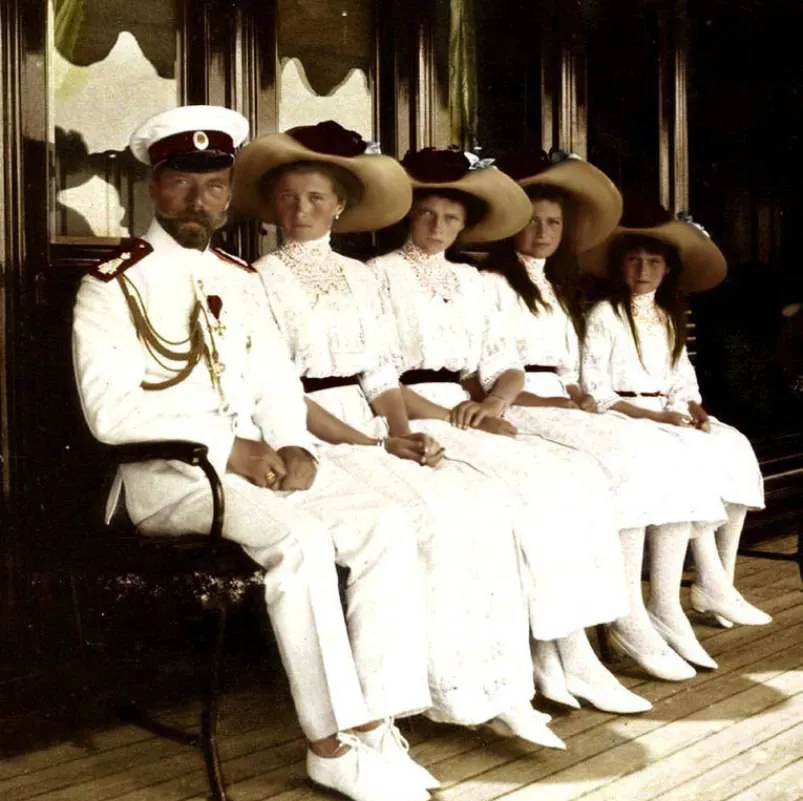
Before their tragic downfall, the Romanovs experienced a lifestyle most of us can only dream of.
Prior to their fall from grace, the emperor and his family enjoyed incredible wealth and luxury, including exotic forms of transportation. This photo shows the Tsar sitting with his four daughters while vacationing on their imperial yacht, the Standart. The Standart was commissioned by Tsar Nicholas's father, Emperor Alexander III. It was reportedly one of the most luxurious vessels of its time, fitted with crystal chandeliers and mahogany paneling, with the idea of making it a floating palace for the royal family. The yacht was also where the royal family were told in 1914 of the assassination of Archduke Ferdinand that would ultimately be the catalyst for the first World War.
The Mystery Surrounding Anastasia’s Death
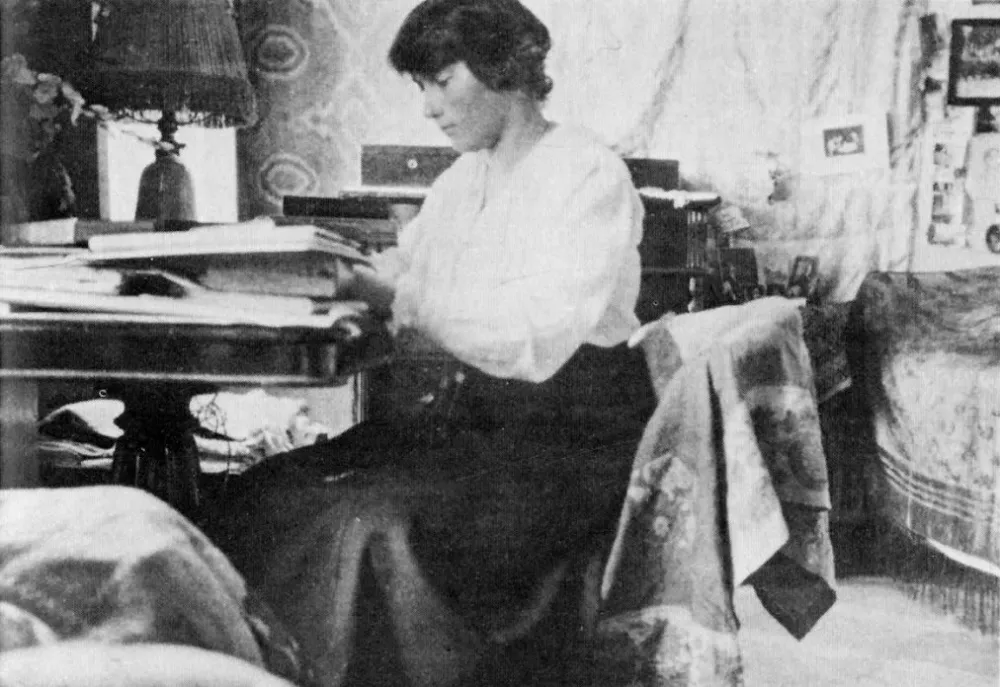
Did Anastasia die with the rest of her family?
This haunting photograph of Grand Duchess Anastasia was taken shortly before her execution while she was being held in captivity at Tobolsk in the spring of 1918. She is sitting at a desk in her bedroom during captivity. There were many false reports of Anastasia’s survival through the 20th century, inspiring books and films. At least ten women claimed to be the Grand Duchess. The best-known imposter was Anna Anderson. Anderson was cremated upon her death in 1984, but DNA testing showed no relation to the Romanov family. However, DNA testing at two grave sites has now identified the four Romanov daughters, their parents, and Alexei, which proved conclusively that the entire family died in 1918.
Tatiana, The Second Eldest
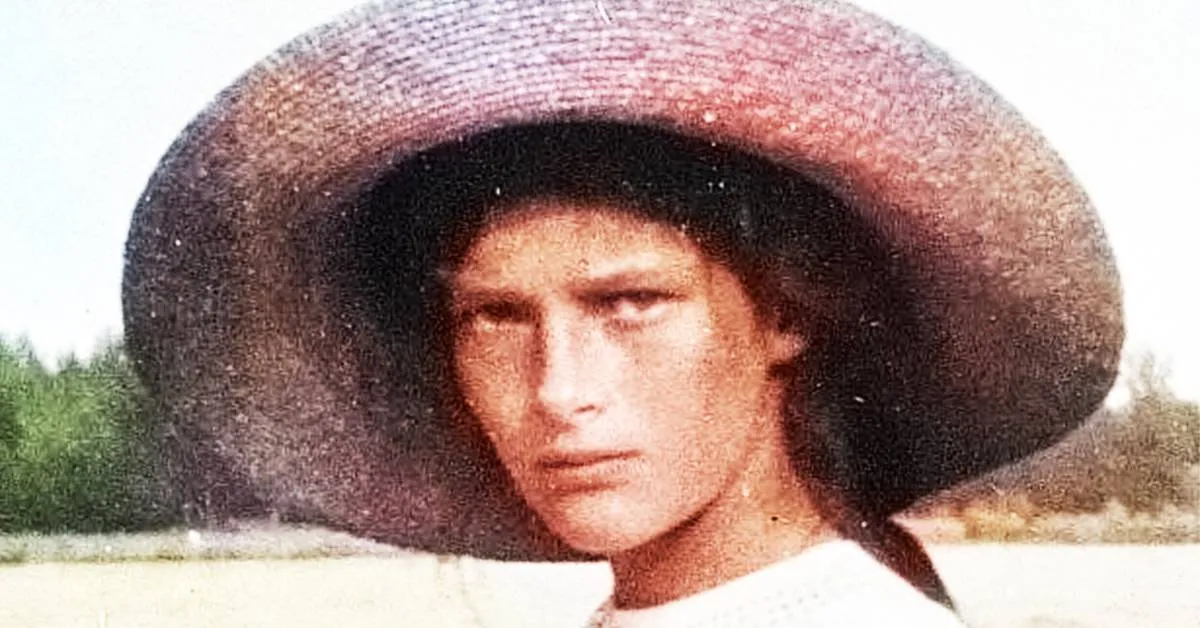
Mystery and scandal surrounded the beautiful Tatiana during her brief life
Tatiana, the second eldest Romanov sister is seen here during one of her family’s summer cruises. Tatiana was widely regarded to be “the most beautiful” of all the Romanov sisters. Her hair was said to be dark auburn and she had blue-grey eyes. It was also said that of all the sisters she most closely resembled their mother. As the rest of the family, Tatiana had a relationship with the “healer” Grigori Rasputin. Rasputin met Tatiana when she was a young girl of around twelve years old but apparently, there was some controversy because he met her and her sisters while they were wearing their nightgowns.
Captivity at Tsarskoe Selo
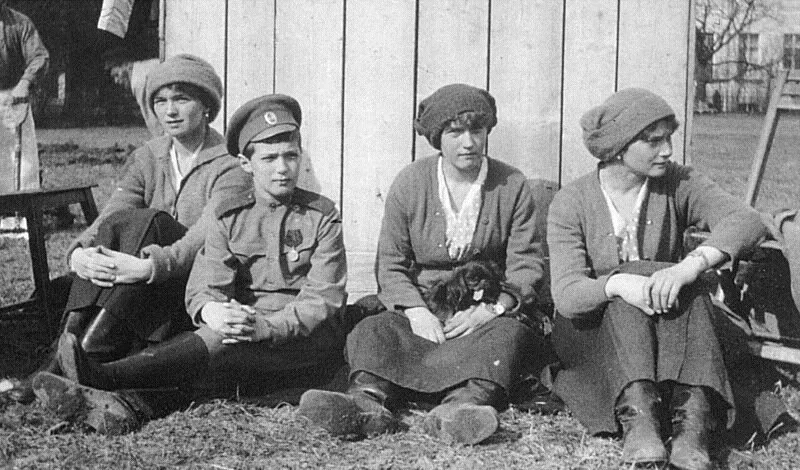
Unfortunately, this house arrest was the beginning of the end for the Romanov family.
The Romanovs’ house arrest started at the Alexander Palace at Tsarskoe Selo. Nicholas II, no longer a monarch and addressed by sentries as Nicholas Romanov, was reunited with his family there while they were held by the Provisional Government and confined to their quarters. The photograph above shows Olga, Alexei, Anastasia, and Tatiana sitting on the ground while being held captive. Anastasia is holding Tatiana’s beloved French bulldog, Ortipo, on her lap. The photograph was taken in May 1917, a couple of months after the Romanov children were reunited with their father and Alexandra was reunited with her husband on March 22, 1917.
Tsar Nicholas II After His Abdication
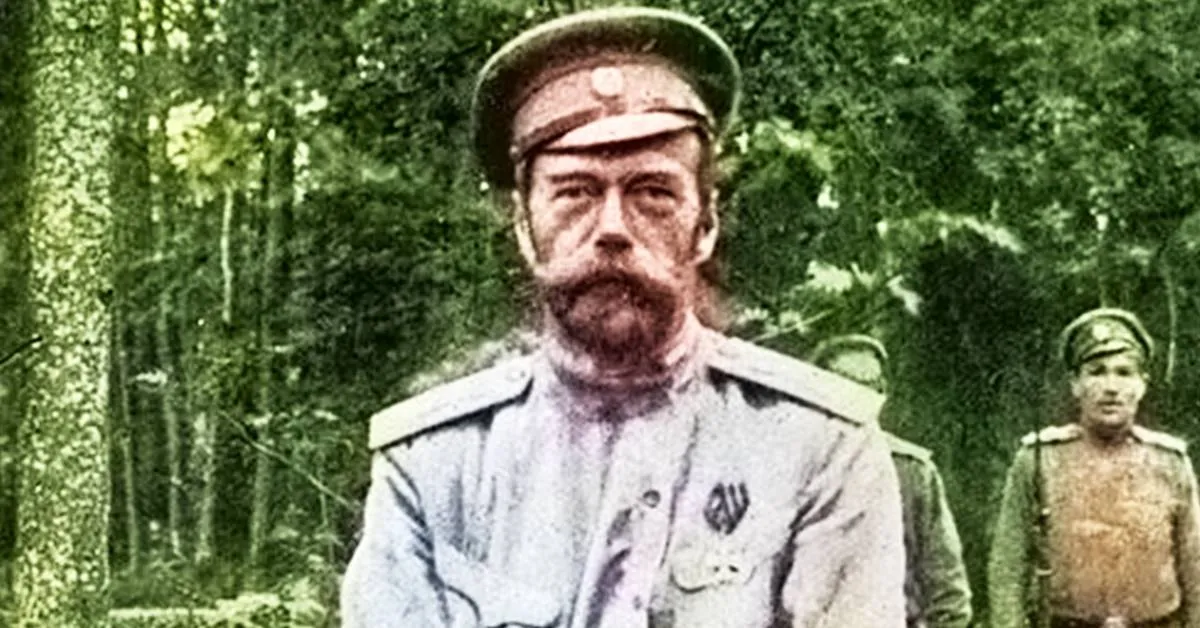
Tsar Nicholas II in a field surrounded by soldiers
For his role in events that killed many millions of Russians, the final Tsar was given the nickname “Nicholas the Bloody.”
Nicholas was the last Emperor of Russia, and his reign saw the fall of the Russian Empire from a great power of the world to economic and military collapse. Nicholas II earned the name Nicholas the Bloody for the events of the Khodynka Tragedy, Bloody Sunday, the violent suppression of the 1905 Revolution, his perceived responsibility for and defeat in the Japanese War, and the anti-Semitic pogroms common under his empire. The estimated 3.3 million Russians killed in World War I and the lack of food and supplies on the home front were ultimately the downfalls of the Romanov dynasty.
He Would Have Never Suspected

The above picture was taken in 1914, four years before their unfortunate execution. "The Big Pair" Olga and Tatiana often cared for Alexei the most, although taking care of a rambunctious little boy got a little out of hand at times. In one instance at a formal dinner party, Alexei reportedly crawled underneath the table and removed the shoe of one of the female guests. After showing his "trophy" to his father, he was told to return it. He obeyed his father's command, but not before putting a strawberry in the toe of the shoe to give the guest a squishy surprise.
In Line For The Throne
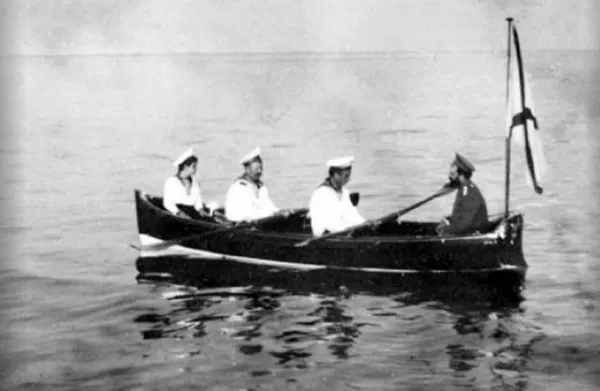
Not knowing that he wouldn't live long enough to ascend the throne, Tsar Nicholas did all he could to prepare Alexei.
Tsar Nicholas II took all the necessary precautions to help prepare Alexei to ascend the throne, even though we know that he would never have the chance to. When Alexei was well, since he often was not in the best of health due to his hemophilia, Tsar Nicholas took his son on outings, often at sea. He also reportedly had Alexei sit in on diplomatic meetings so that he would be acquainted with the various duties and responsibilities that came with being a royal. It might have been a lot to digest for such a young child, but as the only son, he was the one that had to be taught.
Their Innocence Would Soon Be Gone
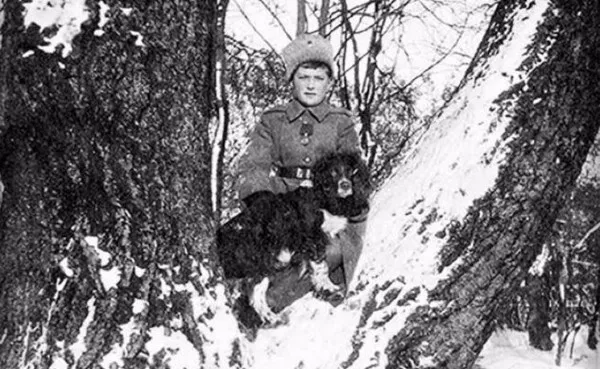
The above picture was taken in 1916, just two years before the Bolsheviks executed the imperial family in 1918. Many people suspected that the poor family dog Joy was killed along with her owners, but apparently, that was not the case. Siberian Times would later report that one of the executioners saw Joy, felt sorry for him and spared his life. Later, the dog was taken to Windsor to live with the English royal family, who was distantly related to Tsarina Alexandra. Joy was lucky to have survived since two of the other family dogs were killed with the family.
Life In Captivity

Taken in 1916, the family didn't know that they would be held captive in Tsarskoe Selo a year later.
The imperial family's favorite vacation spot soon became a place of boredom. While Tsar Nicholas II and his family often enjoyed pleasant outings and retreats in Tsarskoye Selo, all their memories would soon turn sour as they were confined there in the final moments of their lives. Tsarevich Alexei, in particular, was quite frustrated with confinement. Knowing that he had to be very careful because of his hemophilia, he grew so irritated that in his later years he would purposefully injure himself. The Tsarevich wanted to be out and about. He would often accompany his father on military business and in 1916 when the above picture was taken, he was given the title of Lance Corporal.
A Helpful Young Man

When Tsar Nicholas was appointed Commander-in-Chief of the Russian Army, Alexei accompanied him to Stavka, where he may have become inspired by the military life. After being named a Lance Corporal in 1916, Alexei took a particular liking to the foreigners, who enjoyed Alexei's energy and playfulness. British Army officer Hanbury-Williams wrote of Alexei, "As time went on and his shyness wore off he treated us like old friends and... had always some bit fun with us. With me it was to make sure that each button on my coat was properly fastened, a habit which naturally made me take great care to have one or two unbuttoned, in which case he used to at once stop and tell me that I was 'untidy again.'"
Subject To Confinement
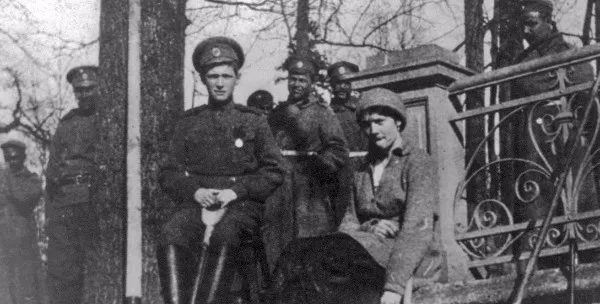
Life in captivity at Tsarskoe Selo was miserable to Tsar Nicholas II's family.
Life in Tsarskoe Selo and later Tobolsk grew incredibly miserable and aimless for Tsar Nicholas's family. Alexie wrote in his diary that he was very "bored," begging God to have "mercy" on him. His anguish is probably what led him to inflict self-harm on himself. Like her sisters, Duchess Tatiana, too, was uncomfortable being held prisoner. While they were sometimes forced to do work, it was never the type of work they wanted to do. They so longed to be out helping nurse wounded soldiers, as they have done throughout World War I. One nurse wrote in a letter that Tatiana "pines without work" and felt that she should be changing bandages.
Alexei, Maria, Tatiana, and Beloved Bulldog Ortipo
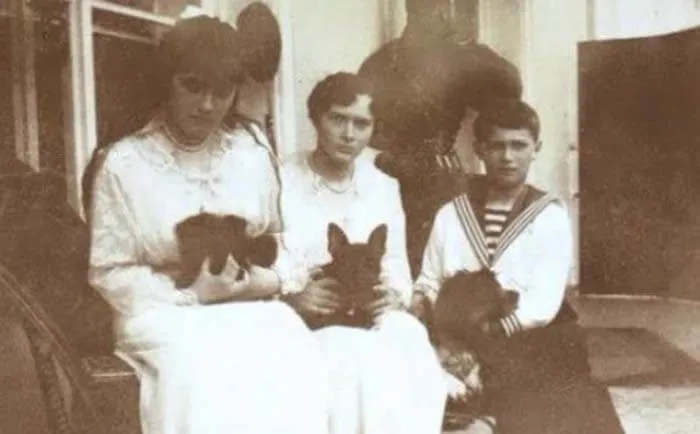
How much more would the family be forced to endure?
This photograph, taken in the spring of 1917 during the Romanov’s captivity, shows Maria, Alexei, Tatiana, and Tatiana’s French bulldog Ortipo sitting on the grounds of Tsarskoe Selo. Ortipo was given to Tatiana while she worked as a nurse during the war by her favorite infirmary patient, Dmitri Malama. The dog was a favorite of the family, and was mentioned frequently in diaries and letters. Ultimately, Ortipo would travel with Grand Duchess Tatiana and the Romanov family as far as Tobolsk, where it was recorded that Tatiana tried to balance the dog and her suitcase in her arms while the family walked in the mud from the train station to their quarters at Tobolsk.
Hard Work During Internment

As we’ll learn, Tatiana was a huge help to her family during their difficult internment.
This photograph from the United States Library of Congress was taken in the spring of 1917. The photo shows Grand Duchess Tatiana during her captivity at Tsarskoe Selo. She transports lumps of sod on a stretcher with the aid of a soldier. It often fell upon Tatiana to hold her family together during captivity. She urged her mother to follow her father to Tobolsk when Alexei was too ill to be transported and helped her sisters and brother sew jewels into their clothing so they could go undetected by guards and would have funding to start a new life if they were able to escape.
Alexei and Tsar Nicholas II Sawing Wood
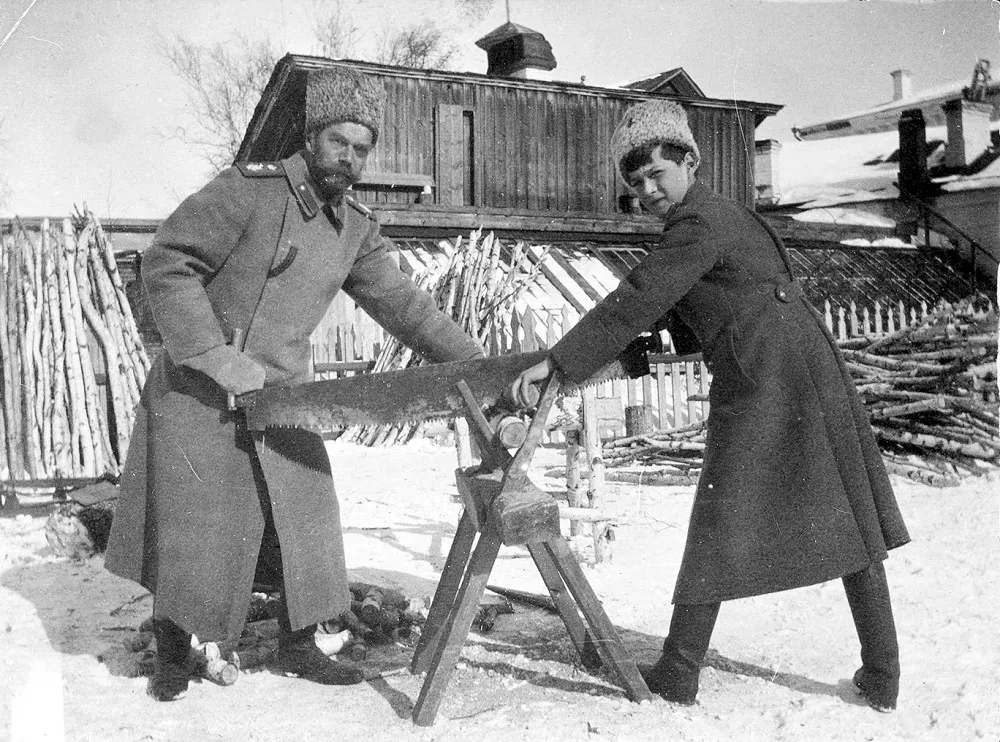
If the Romanovs thought this was as bad as it was going to get, they were dead wrong.
This photograph of Tsarevich Alexei Nikolaevich and Tsar Nicholas II is from the Beinecke Library’s collection of Romanov family photographs and was likely taken by Grand Duchess Maria Nikolaevena. The photograph was taken sometime in the winter of 1917-1918, while the Romanov family was being held captive at Tobolsk. At this time, the family’s conditions were far less comfortable than their initial house arrest, as the Bolsheviks had come to power in October 1917. Alexei and his father are seen sawing wood since they were no longer permitted to have their ten devoted servants by their side. The family was also placed on soldier’s rations during this time.
Anastasia Fooling Around, Before Captivity
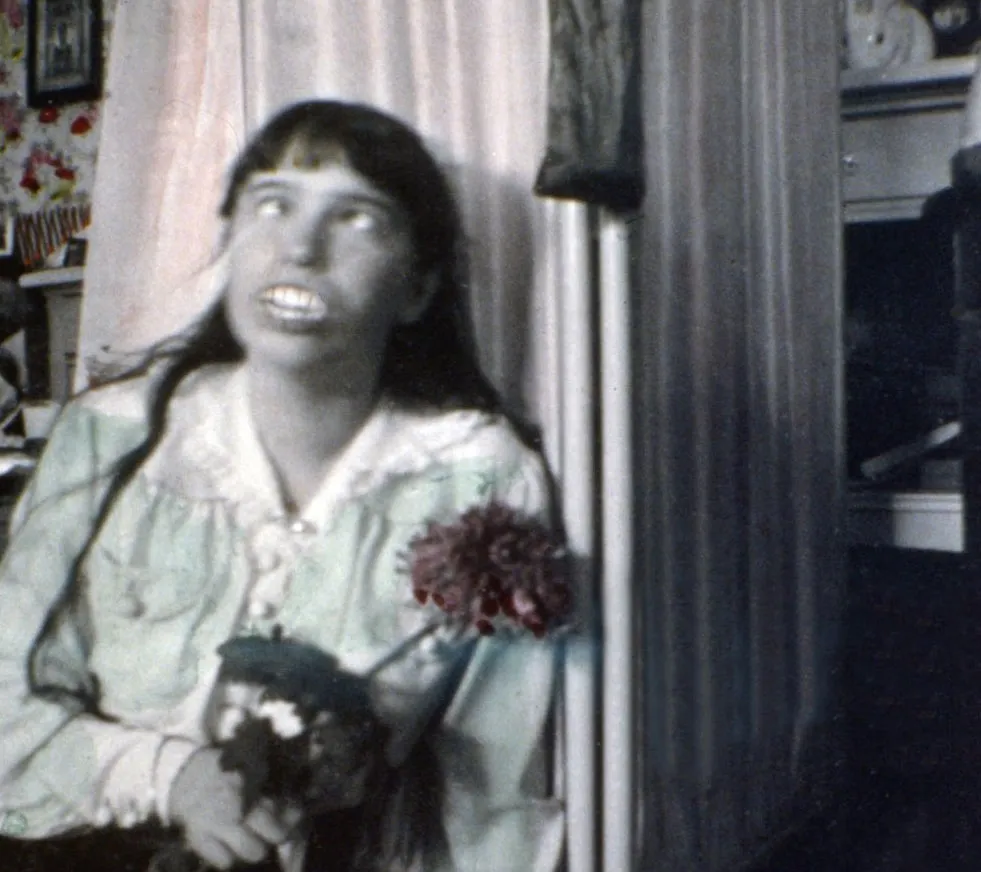
Nice teeth, Anastasia! It turns out that Anastasia was quite a trickster, as we’ll read next.
This photograph of Anastasia was taken before the Romanovs were held captive, between 1915 or 1916. While it may initially look jarring, it simply depicts Anastasia fooling around with a pair of false teeth. Of course, back then false teeth were often made with teeth from the dead. So, with that knowledge, the photo is still a little creepy. Anastasia was known to be vivacious, mischievous, and energetic. She often played pranks on her tutors. Despite her high energy, Anastasia was often in poor health. She bled more than normal when injured, and may have been a carrier of the hemophilia gene like her mother.
The Life Of Anastasia
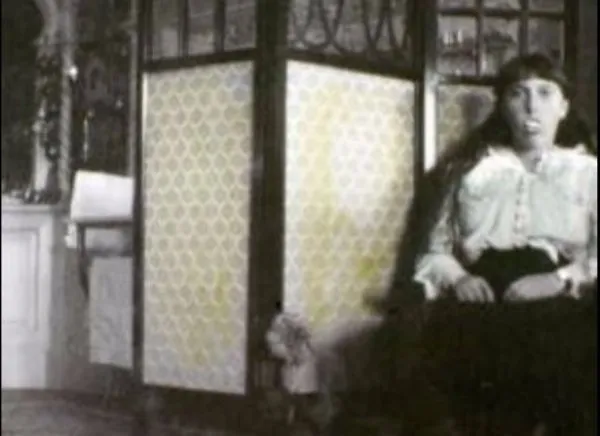
Anastasia was known to be particularly mischevious within her family, often getting into hijinks or daring herself to do naughty things. A source close to the family once wrote of Anastasia, "She undoubtedly held the record for punishable deeds in her family, for in naughtiness she was a true genius." Historians note that in one instance during a snowball fight, Anastasia packed a rock into a snowball and threw it at her older sister Tatiana, who was knocked to the ground. A relative of the family once wrote, "Anastasia was nasty to the point of being evil."
The End Is Near

As we know now, Yakov Yurovsky became the chief executioner of the entire family.
Before their execution, the Romanovs were moved to Yekaterinburg’s Ipatiev House. Around midnight on July 17, 1918, Yakov Yurovsky ordered the family to move to the basement under the pretense that it would be a safe location due to the impending chaos in Yekaterinburg. The family was taken to the cellar room and asked to wait there. They were only given a few seconds to process their orders for execution before they were shot chaotically. At one point, the guards opened the doors to let out the smoke. The Romanov children had jewels sewn into their clothing, which protected them from the initial shots.
Mystery Surrounded The Sisters

Some of Anastasia’s sisters, in particular, were the subject of rampant gossip and rumors.
In this photograph, two of the Romanov sisters are seen posing for the camera along with their mother. Although, it is commonly known that Anastasia was the subject of myth for many years, so was her eldest sister Olga. Although over the years many began to claim they were members of the Russian royal family, one woman named Marga Boodts also staked her claim to royalty and said she was actually the Grand Duchess Olga. Some relatives of the royal family actually believed her to be Olga and Nikolaus the Hereditary Grand Duke of Oldenburg who was a godson of Tsar Nicholas II allegedly financially supported Marga until his death in 1970.
Tatiana & Grigori Rasputin

Rasputin may have conducted himself very inappropriately with the Tsar’s daughters.
The Romanov family revered Rasputin and viewed him and everything he did as “holy”. However, the Tsar’s sister Grand Duchess Xenia Alexandrovna was horrified after she was told by one of the girls’ caretakers who said that Rasputin had visited the two eldest sisters while they were getting ready for bed and was “caressing” them. Xenia apparently viewed Romanov as khlyst which was an offshoot of the Russian Orthodox Church and she regarded him with much suspicion. Ultimately, the caretaker he who viewed Rasputin with suspicion was fired. There were rumors that Rasputin had seduced the four sisters. Ultimately, Rasputin was murdered not long before the royal family themselves were executed.
Tsarina Alexandra Was Avidly Disliked

Did Alexandra to drugs to overcome her shyness?
The Tsarina was widely unliked by her subjects and apparently came across as quite cold. However, Alexandra was apparently not trying to be rude but was rather shy. She was also known to be highly standoffish and only associated herself with a few close friends, which made other aristocrats view her with suspicion. It is possible that in order to deal with her shyness and difficulty in dealing with people she turned to drugs. She at one point confided in one of her few friends that she might have had an addiction to barbiturates. Specifically, one called Veronal and she wrote in a letter a few years before her execution, "I'm literally saturated with it."
Grand Duchess Maria

Two women, claiming to be Anastasia and Maria, came forward after the execution.
The third sister Romanov sister, Grand Duchess Maria, was said to have survived the initial attack on the royal family. Along with her sister Anastasia, after the initial shooting, they were being carried outside to a truck and they "sat up screaming". Some rumors surrounded the possible survival of Maria from the execution. Like her other sisters, people have claimed to be various family members and descendants of Maria’s. However, historians mostly discount the possibility that any of the family survived the attack. In one such story, two young women claimed to be Maria and Anastasia and were taken in by a priest in the Ural Mountains. They were subsequently buried with the names Anastasia and Maria Nikolaevna; however, no proof surrounding the claims has been found.
Grand Duchess Olga

Olga’s future marriage was often the source of speculation in Russian society.
Allegedly, at one point Olga became engaged to Grand Duke Dmitri Pavlovich of Russia, her first cousin once removed. One author named Edvard Radzinsky asserts that the engagement was later broken off because Dmitri strongly disliked Grigori Rasputin. In The Rasputin File, Edvard also says that Dmitri was also rumored to be bi-sexual. Whether the rumors are true or not the betrothal never came to be. Olga was also rumored to be discussing marriage to Prince Carol of Romania, England's George V, and Crown Prince Alexander of Serbia. At some point, Olga fell in love with Pavel Voronov, an officer; however, their relationship could not be because of their differing social status.
Jokester Alexei
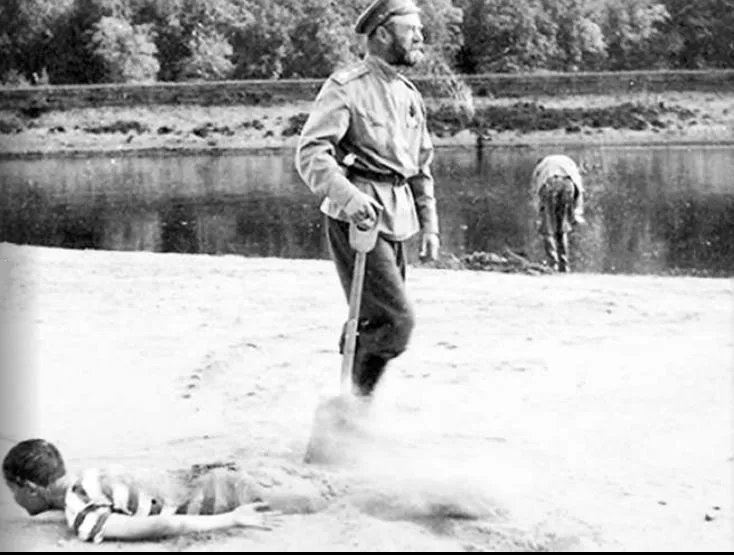
Alexei’s playful nature is shown in this photograph where he is seen playing with his father at the river. In spite of his illness, and undoubtedly to his mother’s chagrin, Alexei played in a rather rough manner. Towards the end of the lives of the royal family, they had been sent to Siberia. There, Alexei had a particularly bad accident while engaging in rough behavior. He decided to ride a sled indoors, down the stairs, and horribly injured himself in the groin area. The hemorrhage was so bad that for the remaining weeks of his life he had to move around in a wheelchair.
Mother And Children Relaxing

Although she loved all of her children, guilt might have led Alexandra to be especially doting on Alexei.
All of the children enjoyed a close relationship with both of their parents. Olga often read books and then recommended them to her mother if they were suitable for her to read. Anastasia was known as being silly and goofy, often teasing and making other family members laugh. When they were little, Alexandra always dressed her daughters in pairs and would have them wear identical clothing. When Alexei was born, he became the apple of the entire family's eye. Alexandra was particularly obsessed with her son especially since she gave him the gene of hemophilia and felt it her duty to protect him.
An Explanation For Friendship With Rasputin?
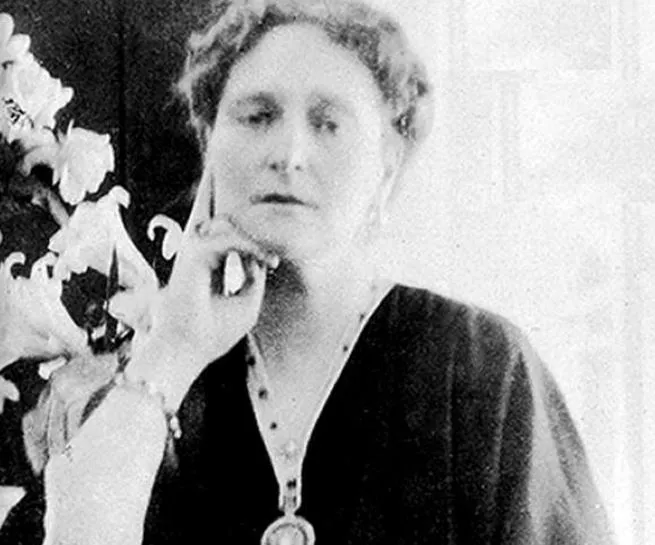
Could her overwhelming need to cure her son of his affliction have been responsible for Alexandra’s friendship with the reputation-destroying Rasputin?
It was Alexandra who brought Rasputin into the family circle, mainly because of her obsession with healing her son. She felt like Rasputin might hold the key to healing hemophilia. Towards the end of her life, Alexandra and the rest of her family were confined, she spent her time in a wheelchair. Either she was suffering from poor health or simply or emotional health was being worn down by the confinement. She, along with her husband the Tsar, was said to have been among the first to have been killed during the execution.
Last Photograph Of Mother And Son

The Tsar reportedly coped with captivity much more easily than his family did. The grim photograph above was taken in 1918, which is the same year the Romanov family was executed. It shows Alexei and his mother Alexandra. The Kerensky government ultimately fell to the Bolsheviks who treated the Royals with even more disdain. In April of that year, the family was moved to Yekaterinburg, which would be their last place before they were executed.
The family, forced into exile, lived completely isolated before their deaths which apparently wore quite heavily on most of the family, with the exception of the Tsar who was said to possess an “internal calm”. The family was also cut off from the outside world and had little news of what was happening so it is unlikely they saw what was coming.









